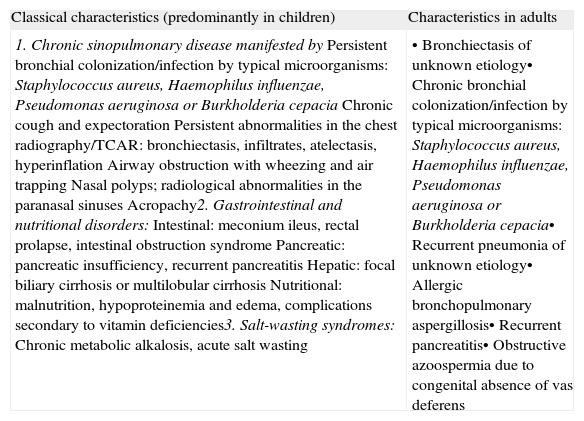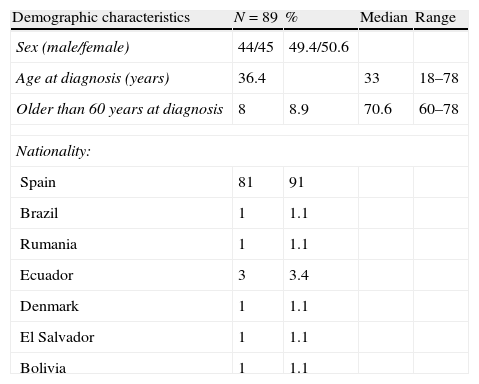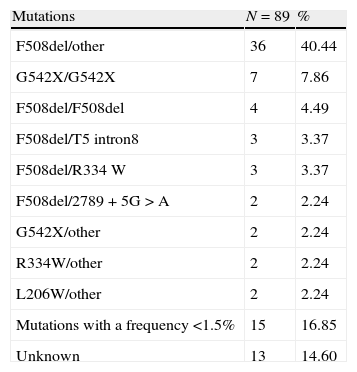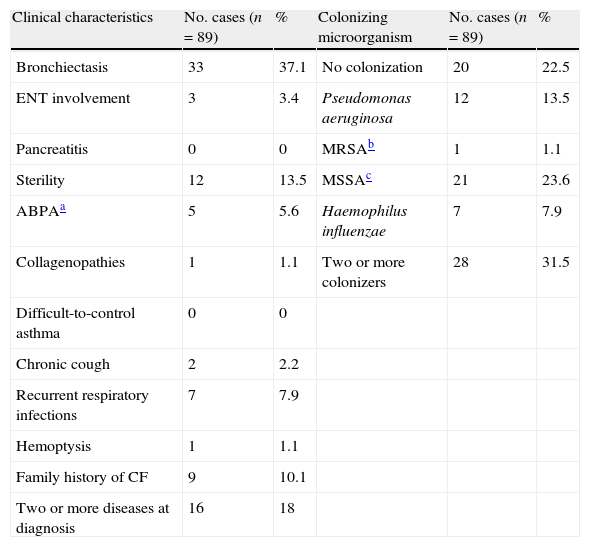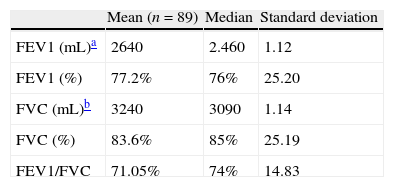To know the prevalence of the patients diagnosed of cystic fibrosis (CF) older than 18 years old of five specific Spanish Units and to analyze their clinical, genetic and microbiological characteristics.
Patients and methodsObservational, cross-sectional, descriptive study of patients diagnosed with CF at age or older than 18 years. The variables analyzed were: current age, age at diagnosis, sex, nationality, lung function parameters, pathologies presented at diagnosis, microbiological features and genetic findings.
ResultsEigthy nine patients (14.8% of the total of 600 CF patients followed at the participating units), of which 45 patients were female (50.6%) and 44 were males (49.4%), were included with a mean age at diagnosis of 36.4 years. Eigthy one patients (91%) were Spaniards. The sweat test was diagnostic in 77 (86.5%) of the patients studied. The sweat test was diagnostic in 77 of the 89 patients studied (86.5%). The most frequently detected mutations were F508del/other and G542X/other, and the most frequent clinical findings at diagnosis were the presence of bronchiectasis in 33 patients (37.1%) followed by sterility in 12 patients (13.5%). The most common colonizing organisms were meticillin-sensitive Staphylococcus aureus (S. aureus) (23.6%) and Pseudomonas aeruginosa (P. aeruginosa) (13.5%). Most patients presented a mild obstructive ventilatory defect and had no pancreatic involvement. The sweat test used to be indeterminate.
ConclusionsCF is also a disease which diagnosis can be in adulthood. CF patients diagnosed in adulthood have a mild lung function and lower incidence of pancreatic involvement, so their prognosis tends to be favorable.
Precisar la prevalencia de enfermos con fibrosis quística (FQ) diagnosticados en edades superiores a los 18 años y analizar sus características clínicas, genéticas y microbiológicas.
Pacientes y métodosEstudio observacional, transversal y descriptivo de todos los pacientes diagnosticados de FQ a edad igual o superior a los 18 años. Las variables analizadas fueron: edad actual, edad al diagnóstico, sexo, nacionalidad, parámetros de función pulmonar, patologías presentes al momento del diagnóstico, características microbiológicas y hallazgos genéticos.
ResultadosSe incluyeron 89 pacientes (14,8%, del total de 600 pacientes en seguimiento en las unidades participantes), 45 mujeres (50,6%) y 44 varones (49,4%), con una edad media al diagnóstico de 36,4 años. Ochenta y un pacientes (91%) eran de nacionalidad española. La prueba del sudor fue diagnóstica en 77 de los 89 estudiados (86,5%). Las mutaciones detectadas con mayor frecuencia fueron la F508del/otra y la G542X/otra y los hallazgos clínicos más frecuentes en el momento del diagnóstico fueron las bronquiectasias en 33 pacientes (37,1%) y la esterilidad en 12 (13,5%). Los microorganismos colonizadores más frecuentes fueron Staphylococcus aureus (S. aureus) sensible a meticilina (23,6%) y Pseudomonas aeruginosa (P. aeruginosa) (13,5%). La mayoría de los pacientes presentaban una alteración ventilatoria obstructiva leve y no tenía afectación pancreática. La prueba del sudor con frecuencia ofreció resultados no concluyentes.
ConclusionesLa FQ es también una enfermedad de diagnóstico en la edad adulta. Los pacientes diagnosticados en edad adulta presentan una función pulmonar levemente alterada y una baja incidencia de afectación pancreática, por lo que su pronóstico tiende a ser favorable.
Article
Diríjase desde aquí a la web de la >>>FESEMI<<< e inicie sesión mediante el formulario que se encuentra en la barra superior, pulsando sobre el candado.

Una vez autentificado, en la misma web de FESEMI, en el menú superior, elija la opción deseada.

>>>FESEMI<<<



